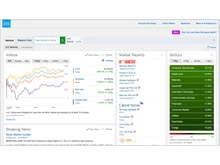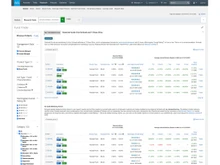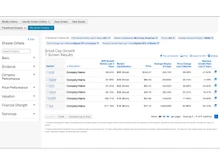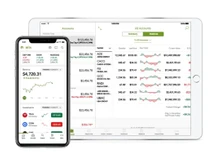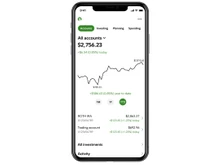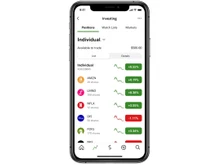Charles Schwab vs Fidelity: Which Trading Platform Is Right for You?
Charles Schwab and Fidelity are professional online trading platforms that offer comprehensive features for active traders and investors to analyze markets, execute trades, and manage risk efficiently. These two tools are not just brokerage apps but technology providers for trading.
Schwab offers a suite of online trading platforms, including the well-known thinkorswim. This software provides powerful tools for analyzing, strategizing, and trading stocks, options, ETFs, and futures. Charles Schwab covers desktop, web, and mobile apps with real-time data, advanced charting, and trade execution features tailored for active trading.
Whereas, Fidelity helps users find opportunities, place trades quickly, and manage portfolios. Its trading software includes streaming quotes, advanced order types, customization, and tools for options, margin, and international trading. Fidelity emphasizes actionable insights powered by AI and real-time market data to help users make informed trading decisions.
Let’s discuss in detail which trading platform is best for your use case.
Key Differences Between Charles Schwab and Fidelity
- Schwab has always been the priority among users for customer service as compared to Fidelity.
- Fidelity fits best for younger investors (35>) because users can't buy fractional shares of ETFs with Schwab.
- Fidelity retail accounts often face problems in transferring funds after one party dies. Its beneficiary procedure can take up to two months, instead of 2 weeks, like in Schwab's retirement and retail accounts.
Charles Schwab vs Fidelity Comparison Table
Fidelity and Charles Schwab are both popular and widely preferred trading platforms with many similar features, but have some distinct differences:
| Feature |
Charles Schwab |
Fidelity |
| Trading Platforms |
Schwab platform, thinkorswim (desktop, web, mobile) |
Fidelity platform, Active Trader Pro (desktop, web, mobile) |
| Asset Types |
Stocks, ETFs, options, mutual funds, futures, forex |
Stocks, ETFs, options, mutual funds, direct crypto trading (3 coins) |
| Cryptocurrency Trading |
No direct crypto, offers crypto ETFs |
Direct trading in 3 cryptocurrencies |
| Futures Trading |
Available |
Not available |
| Paper Trading |
Available (thinkorswim) |
Not available |
| Charting Indicators/Tools |
374 indicators, 24 drawing tools |
129 indicators, 38 drawing tools |
| Watchlist Fields |
Up to 580 fields |
92 fields |
| Custom Study Fields |
35 fields for SMA |
5 fields, no custom studies |
| Order Execution Speed |
Strong |
Slightly faster |
| Educational Resources |
Extensive, high quality |
Extensive, strong in research and data |
| Robo-Advisors |
Schwab Intelligent Portfolios ($5,000 minimum) |
Fidelity Go (no minimum but fees on >$25k) |
| Customer Service |
Strong and highly rated |
Slow and slightly behind Schwab |
How to Choose Between Charles Schwab and Fidelity?
Choosing between Fidelity and Schwab depends on your specific trading needs, preferences, and experience level. Here are key factors to consider for making the best choice:
- Trading Style and Asset Preferences: If you want broad access, including futures, forex, and advanced charting with paper trading to practice, Schwab’s thinkorswim platform is ideal for active technical traders. If you prefer direct cryptocurrency trading along with strong fundamental research and a simpler interface, Fidelity may suit you better.
- Tools and Customization: Schwab offers highly customizable tools, many technical indicators, and advanced charting, which may benefit experienced traders wanting in-depth analysis. Fidelity provides a strong research ecosystem and easy-to-use tools that work well for investors prioritizing fundamentals and fast execution.
- Training and Support: Both platforms offer excellent educational resources. Beginners might find Fidelity’s step-by-step investing guides slightly more approachable. Schwab’s customer service is reputable, which can be helpful when starting.
- Fees and Account Minimums: Both have zero commissions for stocks and ETFs. Schwab requires a $5,000 minimum for its robo-advisor service, while Fidelity Go has no minimum but charges fees on balances over $25,000.
- User Experience: Schwab’s thinkorswim platform is powerful but has a steeper learning curve. Fidelity’s Active Trader Pro is user-friendly but still robust enough for active trading.
When to Choose Charles Schwab or Fidelity?
| Use Case |
Recommended Platform |
| Beginner trader seeking an easy-to-use platform |
Fidelity |
| Active technical trader who needs advanced tools |
Charles Schwab |
| Trader interested in direct cryptocurrency trading |
Fidelity |
| Traders who want access to futures and forex |
Charles Schwab |
| Investors focused on long-term investing and research |
Fidelity |
| Trader requiring low-cost trading fees for stocks and ETFs |
Both |
Quick Recommendations
Which platform offers better analysis tools for active traders?
Charles Schwab leads in advanced analysis tools with its thinkorswim platform, offering over 370 technical indicators and custom scripting capabilities. Additionally, it offers paper trading and robust backtesting. In contrast, Fidelity offers around 129 indicators and is strong in fundamental and research tools, but less customizable technically. Schwab is favored by active technical traders, while Fidelity suits long-term and swing traders who value research.
How do fees differ between Schwab and Fidelity trading accounts?
Both Schwab and Fidelity offer zero commissions for online stock and ETF trades. Options trades have similar per-contract fees ($0.65). Schwab offers free futures trading, not available at Fidelity. Robo-advisor minimums differ: Schwab requires $5,000 minimum with no advisory fees, while Fidelity Go has no minimum but charges fees on accounts above $25,000. Overall, fees are competitive and comparable.
What are the mobile app features of each trading platform?
Both brokers have strong mobile apps for iOS and Android with streaming quotes, mobile options trading, and after-hours trading. Schwab’s app is feature-rich, supporting extensive charting and order customization, but it can be complex. Fidelity’s app is more streamlined and user-friendly, ideal for casual or newer traders focused more on ease of use than technical depth.
Which platform has better customer support and user experience?
Both offer strong customer support and educational resources. Schwab’s customer service is highly rated and provides extensive support for its complex tools. Fidelity focuses on an intuitive user experience, especially for beginner and casual investors, making it easier to learn and navigate. Experienced traders may prefer Schwab’s depth, while beginners might find Fidelity more approachable.
How does each platform handle cryptocurrency and futures trading?
Schwab offers futures trading but does not allow direct cryptocurrency trading. It provides access to crypto-linked ETFs instead. Fidelity supports direct trading in a limited selection of cryptocurrencies but does not offer futures trading. This distinction is important depending on your interest in crypto assets or futures markets.
Final Verdict: Charles Schwab or Fidelity?
Schwab offers a broader range of trading tools, superior charting, futures and forex trading, a paper trading feature, and a highly customizable experience suited for active traders. Whereas Fidelity emphasizes research, direct cryptocurrency trading, a user-friendly platform, and slightly faster order execution.
Both brokers have zero commissions for stocks and ETFs, broad account types, and comprehensive educational resources, making either a strong choice depending on specific trading preferences or needs. Overall, Schwab edges out Fidelity slightly for technical traders and futures, while Fidelity appeals to those interested in cryptocurrency and robust research tools.
You can choose Schwab if seeking a sophisticated, comprehensive trading environment with futures and paper trading. Additionally, opt for Fidelity if you want simpler crypto access, strong research, and a straightforward platform.


 15 Ratings & 10 Reviews
15 Ratings & 10 Reviews


